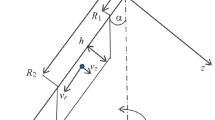Summary
In the preceding study the degree of adsorption of virus to electron microscope grids has been shown to be an important parameter governing the efficiency of sedimentation techniques used for particle counting. In the present study the application of poly-L-lysine not only improves the binding ability but makes it more reproducible. In addition the distribution of adsorbed particles between grid bars and holes is characterized and its importance as an additional parameter for such techniques discussed. For accurate particle titre estimation and for assessing the efficiencies of sedimentation techniques in virus diagnostics the product of these parameters represents a correction factor which must be taken into consideration. Furthermore it could be demonstrated, using the technique here described, that virus contained in a drop of suspension became homogeneously distributed over the surface of a poly-L-lysine treated grid after drying. This phenomenon makes possible the estimation of a titre through particle counting on gravimetrically determined volumes.
Similar content being viewed by others
References
Ball, F. J., Harris, W. W.: Predictability of quantitation of small virions by electron microscopy. Proc. Soc. exp. Biol. Med.139, 728–733 (1972).
Geister, R., Peters, D.: Ein vereinfachtes direktes Zählverfahren für Virussuspensionen ab 105 Partikel/ml. Z. Naturforsch.18b, 266 (1963).
Gelderblom, H., Reupke, H., Warring, R.: Über den Einsatz der Airfuge in der elektronenmikroskopischen Virusdiagnostik. GIT Fachzeitschrift für das Laboratorium22, 17–19 (1978).
Marquard, J., Holm, S. E., Lycke, E.: Preparation of purified vaccinia virus freed from soluble antigen. Proc. Soc. exp. Biol. Med.116, 112–116 (1964).
Müller, G.: Elektronenmikroskopische Partikelzählung in der Virologie. I. Zentrifugierröhrchen zur direkten Sedimentation von Viren auf Netzträger. Arch. ges. Virusforsch.27, 339–351 (1969).
Müller, G., Nielsen, G.: Elektronenmikroskopische Partikelzählung in der Virologie. II. Ursachen systematischer Fehler bei Sedimentationsverfahren. Arch. ges. Virusforsch.30, 22–30 (1970).
Sanders, S. K., Alexander, E. T., Braylan, R. C.: A high-yield technique for preparing cells fixed in suspension for scanning electron microscopy. J. Cell Biol.67, 476–480 (1975).
Strohmaier, K.: A new procedure for quantitative measurements of virus particles in crude preparations. J. Virol.1, 1074–1081 (1967).
Wigand, R., Nielsen, G.: Zur Frage der Existenz löslicher und virusgebundener Anteile von komplementbindenden Antigene und Haemagglutininen des Vacciniavirus. Arch. ges. Virusforsch.10, 215–225 (1960).
Author information
Authors and Affiliations
Rights and permissions
About this article
Cite this article
Müller, G., Nielsen, G. & Baigent, C.L. Electron microscopical particle counting in virology. Archives of Virology 64, 311–318 (1980). https://doi.org/10.1007/BF01320616
Received:
Accepted:
Issue Date:
DOI: https://doi.org/10.1007/BF01320616




